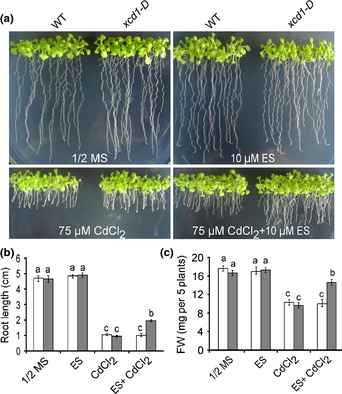研究揭示植物响应重金属信号转导机制
来源:《新植物学家》
作者:曹树青
时间:2014-12-03


本报讯(通讯员周慧 记者杨保国)土壤重金属污染是全球面临的重要环境问题之一。近日,合肥工业大学教授曹树青课题组的一项研究,首次揭示了植物响应重金属镉胁迫信号转导的分子调控机制,为土壤重金属污染植物修复基因工程提供了新的技术途径和基因资源。该成果在线发表于《新植物学家》。
我国有近20%的耕地存在镉、砷、汞、铅、镍、铜等重金属超标,而土壤中重金属可通过农作物吸收进入食物链,严重影响食品安全并危及人类健康。曹树青介绍说,通过物理和化学手段治理土壤重金属污染非常困难,也容易造成二次污染。
曹树青课题组利用正向遗传学途径筛选和鉴定了一个拟南芥耐镉突变体,并克隆了其相应的基因。在镉离子胁迫条件下,该基因被诱导表达,进而合成植物鏊合素,将镉离子进行螯合并将其运输至液泡中储存,从而增加了植物对镉的积累和耐受。大量实验表明,过量表达MAN3基因的拟南芥植株,在重金属镉污染的土壤中仍然保持正常生长状态。(来源:中国科学报 周慧 杨保国)
MAN3 gene regulates cadmium tolerance through the glutathione-dependent pathway in Arabidopsis thaliana
Abstract Pollution of soil by the heavy metal cadmium (Cd) is a global environmental problem. The glutathione (GSH)-dependent phytochelatin (PC) synthesis pathway is one of the most important mechanisms contributing to Cd accumulation and tolerance. However, the regulation of this pathway is poorly understood. Here, we identified an Arabidopsis thaliana cadmium-tolerant dominant mutant xcd1-D (XVE system-induced cadmium-tolerance 1) and cloned XCD1 gene (previously called MAN3), which encodes an endo-β-mannanase. Overexpression of MAN3 led to enhanced Cd accumulation and tolerance, whereas loss-of-function of MAN3 resulted in decreased Cd accumulation and tolerance. In the presence of estradiol, enhanced Cd accumulation and tolerance in xcd1-D was associated with GSH-dependent, Cd-activated synthesis of PCs, which was correlated with coordinated activation of gene expression. Cd stress-induced expression of MAN3 and the consequently increased mannanase activity, led to increased mannose content in cell walls. Moreover, mannose treatment not only rescued the Cd-sensitive phenotype of the xcd1-2 mutant, but also improved the Cd tolerance of wild-type plants. Significantly, this mannose-mediated Cd accumulation and tolerance is dependent on GSH-dependent PC concentrations via coordinated control of expression of genes involved in PC synthesis. Our results suggest that MAN3 regulates the GSH-dependent PC synthesis pathway that contributes to Cd accumulation and tolerance in A. thaliana by coordinated control of gene expression.
原文链接:http://onlinelibrary.wiley.com/doi/10.1111/nph.13101/pdf




